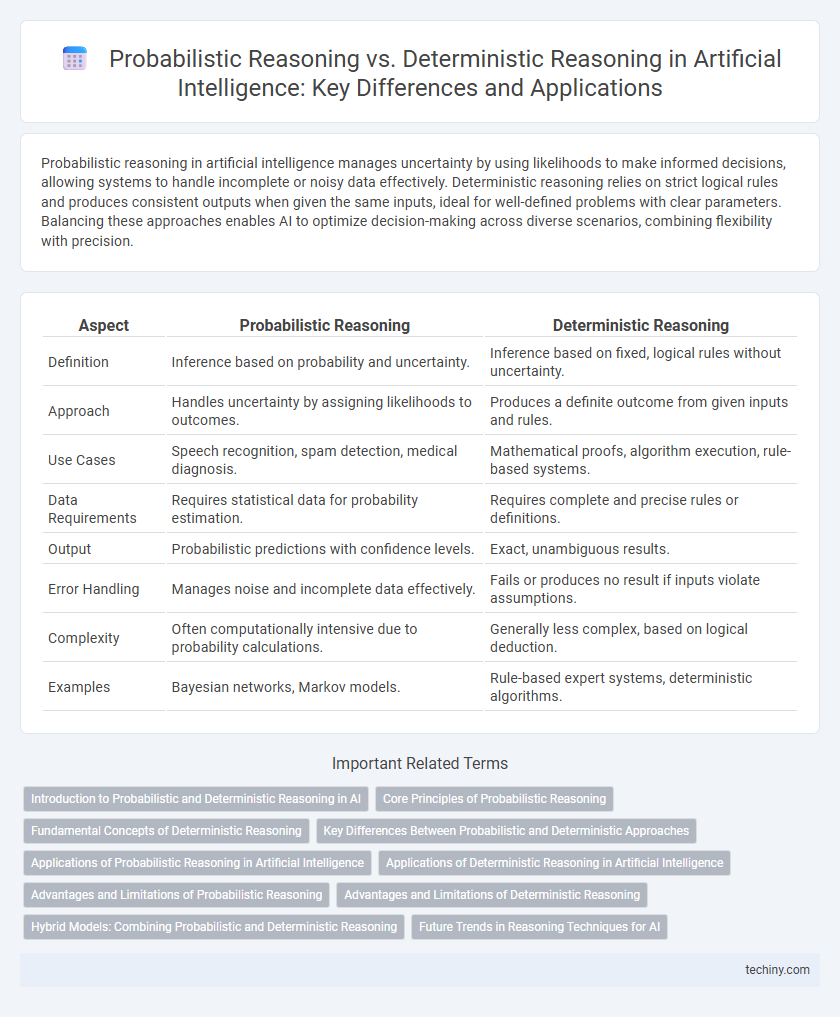Probabilistic reasoning in artificial intelligence manages uncertainty by using likelihoods to make informed decisions, allowing systems to handle incomplete or noisy data effectively. Deterministic reasoning relies on strict logical rules and produces consistent outputs when given the same inputs, ideal for well-defined problems with clear parameters. Balancing these approaches enables AI to optimize decision-making across diverse scenarios, combining flexibility with precision.
Table of Comparison
| Aspect | Probabilistic Reasoning | Deterministic Reasoning |
|---|---|---|
| Definition | Inference based on probability and uncertainty. | Inference based on fixed, logical rules without uncertainty. |
| Approach | Handles uncertainty by assigning likelihoods to outcomes. | Produces a definite outcome from given inputs and rules. |
| Use Cases | Speech recognition, spam detection, medical diagnosis. | Mathematical proofs, algorithm execution, rule-based systems. |
| Data Requirements | Requires statistical data for probability estimation. | Requires complete and precise rules or definitions. |
| Output | Probabilistic predictions with confidence levels. | Exact, unambiguous results. |
| Error Handling | Manages noise and incomplete data effectively. | Fails or produces no result if inputs violate assumptions. |
| Complexity | Often computationally intensive due to probability calculations. | Generally less complex, based on logical deduction. |
| Examples | Bayesian networks, Markov models. | Rule-based expert systems, deterministic algorithms. |
Introduction to Probabilistic and Deterministic Reasoning in AI
Probabilistic reasoning in AI involves handling uncertainty by using probability distributions to model and infer the likelihood of various outcomes, enabling systems to make decisions under incomplete or noisy data. Deterministic reasoning, on the other hand, operates on fixed rules and logic, producing predictable and consistent results when presented with the same inputs. Understanding the distinction between probabilistic and deterministic reasoning is crucial for designing AI systems that effectively balance flexibility and precision in problem-solving.
Core Principles of Probabilistic Reasoning
Probabilistic reasoning relies on the core principle of uncertainty quantification through probability distributions to model and infer from incomplete or noisy data. It employs Bayes' theorem for updating beliefs based on new evidence, enabling adaptive decision-making in dynamic environments. This approach contrasts deterministic reasoning by allowing flexible predictions and handling ambiguity inherent in real-world AI applications such as speech recognition and autonomous systems.
Fundamental Concepts of Deterministic Reasoning
Deterministic reasoning operates on the principle that a given input will always produce the same output, relying on fixed rules and logical deduction. It assumes certainty in the relationships between variables, enabling exact predictions and conclusive decision-making in artificial intelligence systems. This approach contrasts with probabilistic reasoning by excluding randomness and emphasizing predictable, rule-based inference.
Key Differences Between Probabilistic and Deterministic Approaches
Probabilistic reasoning in artificial intelligence deals with uncertainty by using likelihoods and probability distributions, enabling systems to handle incomplete or noisy data effectively. Deterministic reasoning relies on fixed rules and definitive outcomes, ensuring predictable and consistent results given the same inputs. Key differences include probabilistic models' flexibility in managing ambiguity versus deterministic models' strict rule-based decision-making, impacting applications in machine learning, expert systems, and decision support.
Applications of Probabilistic Reasoning in Artificial Intelligence
Probabilistic reasoning in artificial intelligence enables systems to handle uncertainty by calculating likelihoods, making it essential for applications like natural language processing, computer vision, and autonomous robotics. It improves decision-making processes in medical diagnosis, fraud detection, and predictive analytics by modeling incomplete or noisy data. Unlike deterministic reasoning, which follows fixed rules, probabilistic models such as Bayesian networks and Markov decision processes allow AI to adapt to dynamic and ambiguous real-world environments.
Applications of Deterministic Reasoning in Artificial Intelligence
Deterministic reasoning in artificial intelligence is crucial for applications requiring guaranteed outcomes, such as automated theorem proving, formal verification, and expert systems used in medical diagnostics. These systems operate under fixed rules and produce consistent, predictable results essential for safety-critical domains like autonomous vehicles and aerospace control systems. By applying deterministic algorithms, AI ensures reliability and transparency in decision-making processes where uncertainty must be minimized.
Advantages and Limitations of Probabilistic Reasoning
Probabilistic reasoning excels in handling uncertainty by quantifying the likelihood of various outcomes, making it essential for real-world AI applications such as natural language processing and medical diagnosis. Its ability to update beliefs with new evidence enables flexibility and adaptability but is computationally intensive and can struggle with incomplete or biased data. Unlike deterministic reasoning, which guarantees specific outcomes, probabilistic models sacrifice precision for robustness in uncertain environments.
Advantages and Limitations of Deterministic Reasoning
Deterministic reasoning in artificial intelligence offers clear advantages such as predictability and repeatability, making it ideal for applications requiring precise and consistent outcomes. Its limitations include inflexibility and inability to handle uncertainty or incomplete information, which restricts its effectiveness in dynamic or ambiguous environments. This approach excels in rule-based systems but struggles with real-world complexities where probabilistic reasoning provides more adaptable solutions.
Hybrid Models: Combining Probabilistic and Deterministic Reasoning
Hybrid models merging probabilistic and deterministic reasoning enhance AI decision-making by leveraging the strengths of both approaches; probabilistic reasoning captures uncertainty through statistical inference, while deterministic reasoning applies strict logical rules for precise conclusions. These integrated frameworks enable robust handling of complex real-world scenarios such as autonomous driving, where uncertain sensor data must interact with predefined safety protocols. By uniting probabilistic models like Bayesian networks with deterministic logic programming, hybrid systems improve accuracy, adaptability, and interpretability in AI applications.
Future Trends in Reasoning Techniques for AI
Probabilistic reasoning in AI leverages uncertainty modeling through Bayesian networks and Markov decision processes, enabling systems to make informed predictions despite incomplete information. Deterministic reasoning methods, characterized by rule-based logic and exact inference, are evolving to integrate with probabilistic approaches, enhancing robustness and interpretability. Future AI reasoning techniques trend towards hybrid models combining probabilistic and deterministic paradigms to improve decision-making accuracy in complex, dynamic environments.
Probabilistic Reasoning vs Deterministic Reasoning Infographic

 techiny.com
techiny.com